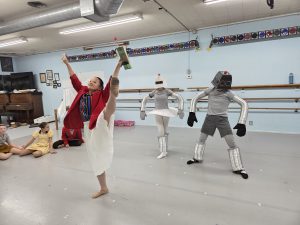After years of dreaming, planning and discussion, the work to bring BART to Santa Clara is officially underway. On Friday, June 14, leaders from BART, VTA, San Jose and Santa Clara picked up shovels and ceremonially tossed the first shovelful of dirt at the future site of the Newhall BART yard.
“The project will provide better access to all of our local amenities, including shopping, dining, recreational facilities and community life,” Santa Clara Mayor Lisa Gillmor told the crowd. “But lastly and importantly, it will benefit our Santa Clara University students, faculty and staff.
“Because of our close proximity, it will offer reliable and affordable access to the university, helping them save money on transportation costs, allow them to explore regional job opportunities and engage in cultural activities, really enhancing their educational experience,” Gillmor continued.
The Newhall BART yard is located near the intersection of Coleman Avenue and Brokaw Road, across Brokaw from Costco. It’s right on the border of Santa Clara and San Jose, meaning it will be a shared facility by both cities.
For the people behind the project, this shared space is only another example of the long-time efforts to unite the entire Bay Area as one giant community.
“The project is a critical step in fulfilling the long-standing vision of ringing the Bay with high-quality green transit passenger rail,” said Carolyn Gonot, VTA general manager and CEO. “We are not just building a transportation system, we are creating a legacy of environmental stewardship and economic viability. By connecting our cities, we are laying the groundwork for a future where public transit is the backbone of regional mobility, reducing our carbon footprint and promoting a healthier, more sustainable Bay Area.”
For Santa Clara County Supervisor and VTA Board Chair Cindy Chavez, it’s about uplifting all Bay Area communities.
“We know that without education, we can’t lift their communities up. We know that without health care, we can’t lift our communities up. But what we have to acknowledge is if we can’t connect people to opportunities, we can’t lift our communities up,” said Chavez.
When finally completed, the BART extension is expected to save the average rider 30 minutes on a 50-mile commute. It’s also expected to offer increased access to jobs for hundreds of thousands of people and reduce greenhouse gas emissions.
For California Transportation Commission Chair Carl Guardino and former San Jose Mayor Ron Gonzalez, this is a major milestone in realizing a vision that they had more than three decades ago.
“As I stand beside former San Jose Mayor Ron Gonzalez, we had a simple but important dream to ring the Bay with rail, and we are going to realize that dream, 30 years in the making,” said Guardino.
Phase II of the BART extension will end in Santa Clara. Trains are expected to start running in 2037.
Right now, crews are preparing for the arrival of the Tunnel Boring Machine, a massive drill that will create a tunnel 54 feet in diameter for trains to travel through. The Tunnel Boring Machine will burrow underground, creating a two train wide tunnel that connects Santa Clara to the Berryessa/North San Jose BART station.












So odd they couldn’t build it by the airport. It is right across the street!
In the late 1960’s, my company bid on a small BART sub-contract and got it. We got a lot of documents to ponder over, a couple of which were about riders’ residences vs that same riders’ place of work. It’s been a while but I think it was based on ZIP codes. When transferred to a map of the SF Bay, it looked like a a lot of random lines crossing each other. At one point, an accompanying map was produced taking into account the Bay and the proposed BART routes. It was the basis for the track layouts, but stopped in Fremont – the end of the line. Most of us in the office came to the same conclusion – to be successful, BART had to go all the way around the SF Bay, with feeders from Vallejo, Livermore, San Jose and the entire peninsula with side trips to all three Bay Area Airports, all sports stadiums, railroad depots, cruise ship piers and other places of interest (the SF Zoo). I rode BART in the late 80s from Fremont to the financial district in San Francisco for a week of school. It was not a pleasant week of travel.
My opinion is, if they’re bringing BART to different cities, why don’t they just extend the system to the entire state? Public rail transportation in California in general is quite poor in a state that’s overpopulated and with high levels of highway congestion.
Besides, we don’t have to change the name much either. We can call it CART.